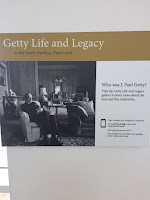 Although living in Los Angeles my entire life,
the Getty center had never crossed my mind to visit. As I decided to visit this
museum for this class, i was still oblivious to what the main concept of this
museum was. After taking the tram to the beginning of the Getty center, I soon
found out about the medieval art.
Although living in Los Angeles my entire life,
the Getty center had never crossed my mind to visit. As I decided to visit this
museum for this class, i was still oblivious to what the main concept of this
museum was. After taking the tram to the beginning of the Getty center, I soon
found out about the medieval art.
One of the
first pictures I saw was this one, which is described as cupids looking down on
these people. This Shows the allegory of the picture to be love. This picture
was created using oils painted on a canvas.
This next
picture was a portrait painting of Tzioano Valley, who was considered to be the
greatest portrait painter in Europe during his lifetime. Most of his
paintings were all the same genre, standing portraits. He painted this portrait
to allow us viewers to see both the physical and mental stress he was enduring
before going into battle with his army. As he is lost in his thoughts, he is
oblivious to the child attempting to hand him his helmet. With his hand placed
on his sword, you are able to see his is ready to take on whatever is
ahead.
After
visiting this museum, I was really able to relate it to week one's topic of two
cultures. Using art, these artists were able to express historical events and
important dates in history. The only times I have seen similar pictures like
this in history books. It was very intriguing to witness these pieces of art in
person, especially looking at it with a different point of view with these two
cultures idea.













